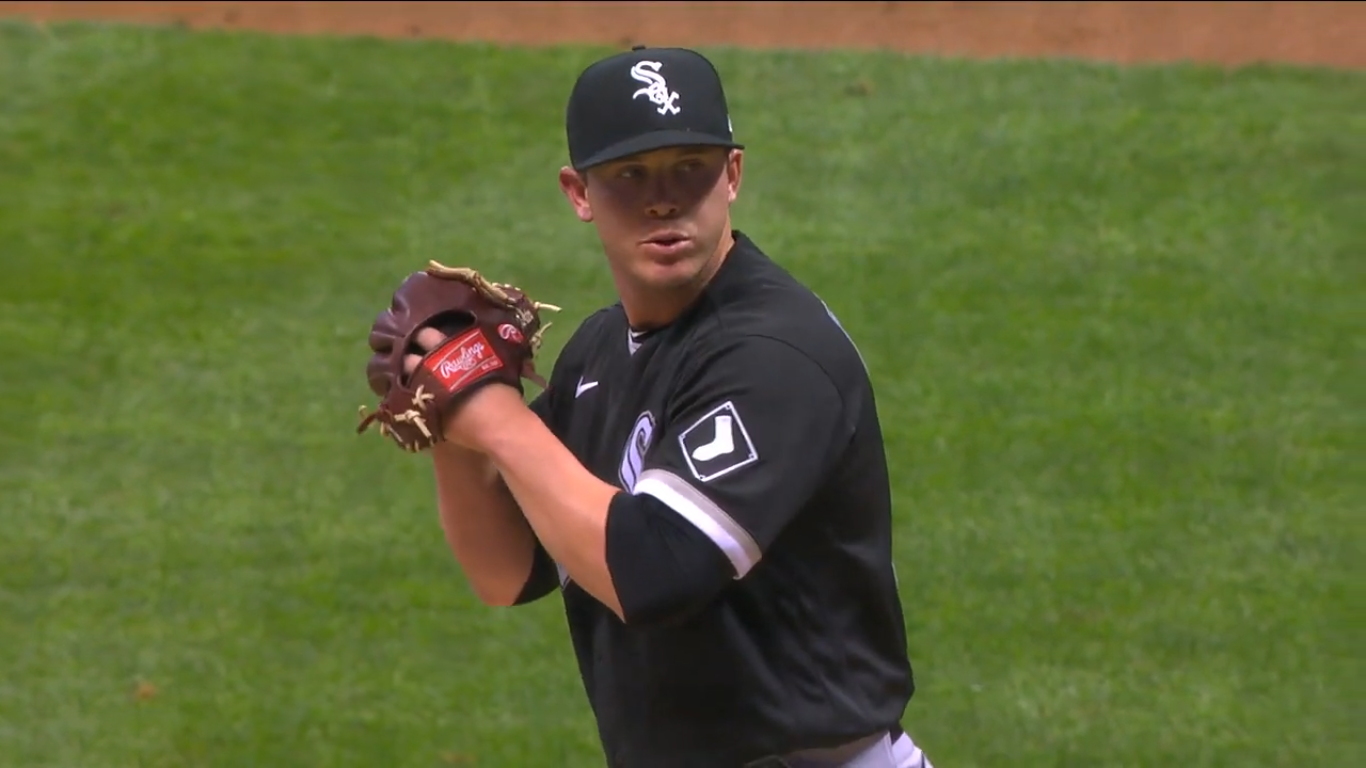White Sox rookie review: Matt Foster

Despite there being no minor league season in 2020, there were a significant number of White Sox prospects who made big strides. The White Sox had 12 players make their MLB debuts. We are taking a look back at how they fared and what it means for their future. Codi Heuer was the first reliever on our list, next up is Matt Foster.
RELEVANT STATS
Regular Season: 28.2 IP, 2.20 ERA, 31 K, 9 BB, 16 H (23 appearances)
Playoffs: 0.1 IP, 0 R, 0 K, 2 BB, 0 H (1 appearance).
UNDER THE RADAR
The fact that we’re writing about Foster as one of the White Sox rookies this year should not come as a major surprise. Prior to the season, farm director Chris Getz hinted at the possibility of Foster making it to Chicago during this season, even before the pandemic forced the team to dig deep(er than expected) into its minor league arms.
That said, Foster’s performance during the year was somewhat unexpectedly good — unless you’re FutureSox’ Rob Young, who saw the potential in the right-hander as far back as 2017. The White Sox must have known what they were doing when they took Foster in the 20th round of the 2016 draft out of the University of Alabama, as he impressed at every stop during his minor league career.
A short stint away from baseball did not deter the organization from sticking with Foster, and the White Sox quietly placed him on the 40-man roster to protect him from the Rule 5 draft in December of 2019. His rising status within the organization led to more outlets taking notice, and Foster told FutureSox’ Mike Rankin in March that he was hopeful of getting to the big leagues in 2020 after making huge strides thanks to an increased usage of analytics.
Then came the 2020 season.
PLEASANT SURPRISE
Foster did not start the season with the big league club, but he received the call to the majors very early into the season. On July 29, 2020, the White Sox announced that Jimmy Lambert was placed on IL and Foster was called up to Chicago. Foster was eased into the league, as he made his debut on August 1 against the Kansas City Royals during an 11-5 White Sox win. He pitched one inning, gave up one hit and struck out one. He threw 11 of his 16 pitches for strikes.
After his second appearance, two days later against Milwaukee, Foster went multiple innings for the first time. He pitched two innings in relief, giving up no hits, walking one and striking out three. Using his fastball and changeup, Foster threw 24 of 34 for strikes and induced 7 swinging strikes; his eventual season-high. From then on, he took off running.
OPENER
After showing that he was capable of going multiple innings, manager Rick Renteria deployed him as an opener twice during the season. The first time was against Cleveland (2.0 IP, 0 H, 1 BB, 3 K). A week later, the rookie started Game 2 of a doubleheader against St. Louis (2.0 IP, 0 H, 0 BB, 2 K). Foster did not give up his first runs until his 10th appearance. He ended the regular season 6-1, tied for fourth most wins in the AL, with a 2.20 ERA (7 earned runs in 28.2 innings pitched), a 2.88 FIP, 3.85 xFIP, 9.73 K/9, 2.83 BB/9, and 0.6 fWAR. He struck out 28.4% of all batters faced, up 7% from the major league average.
In the postseason, the rookie was thrust into a relief appearance that was destined to fail. Foster replaced an erratic Carlos Rodon and inherited the bases loaded. The usually so reliable right-hander could not find the strike zone. He threw 9 of his 12 pitches outside the strike zone. He walked in two runs before ending the inning and closing the book on an otherwise tremendous rookie season.
STEADY PRESENCE
So what made Foster such a steady presence in the White Sox bullpen in 2020? The answer is simple: the changeup. End of article, right?
No, there is of course more to it than just the changeup, but let’s soak in the beauty of Foster’s off-speed skills with some help of Rob Friedman, who took notice of the pitch on several occasions this season.
Foster’s changeup became a force to be reckoned with, but the pitch was not always this good. The right-hander credits his minor league pitching coach Matt Zaleski for the progression he made with the pitch.
“When I first started, I had a good slider, but didn’t have a changeup at all,” Foster said in spring training before the shutdown. “I got hounded by him about throwing and showing my changeup.”
Whatever Zaleski saw in the pitch, he was right. Now, we can drool endlessly over the nasty nature of these changeups, but they’re obviously not the only thing that made Foster thrive this season. A dive into his statcast data reveals several interesting underlying elements of Foster’s success. It also further cements a belief in its sustainability.
CONSISTENCY
Some of that belief comes from the fact that Foster appears to have taken what made him successful in the minor leagues to the majors. We can take several quotes and observations from the aforementioned Rob Young article from 2017, and see the exact same things play out in 2020.
In 2017, Zaleski told FutureSox: “[Foster] throws a ton of strikes with all his pitches and he comes right at you.” In 2020, this still proved to be the case, as over half of Foster’s pitches were inside the zone, at 52.3% (league average: 48.4%). Zaleski also noted: “He throws his fastball both sides of the plate and down, with good down angle with a little bit of cut to it.” When looking at Foster’s edge chart, it indeed shows an above average Edge%, at 43.2% (league average: 39%).

The consistent nature of his zoning is visible in Foster’s splits as well. Whether he faces a left-handed or a right-handed hitter, the results are virtually the same: 2.03 ERA / 0.98 WHIP / 13 K / 4 BB vs. 53 LH batters; 2.35 ERA / 0.78 WHIP / 18 K / 5 BB vs. 56 RH batters.
DELIVERY AND RELEASE POINT
The other element that made Foster’s changeup so good, was the consistent delivery and release point of all his pitches. By ‘tunneling’ his pitches and keeping his release point as consistent as possible, the 10 mph difference between his fastball (93.8 mph average) and changeup (83.8 mph) did most of the work for him.
When we look at the average break for both pitches, we can see how well they complement each other. Foster’s four-seamer has an average horizontal break of -9.6 inches. His changeup has a very similar horizontal break at -7.8. This keeps both pitches more or less in the same ‘tunnel’ for a long time. It isn’t until the changeup starts its vertical drop that it becomes the dangerous weapon that it is. Whereas the four-seamer on average breaks -12.9 inches vertically, his changeup breaks breaks double that amount, at -25.9 inches.

Red is his four-seamer, green is the changeup, yellow the slider. (Statcast)
With both pitches staying on a similar horizontal plane, while maintaining a substantially different vertical drop, the combination proved to be lethal for Foster, especially with his steady, even release point. Sidenote: Foster’s slider lives on the inside part of the plate against right-handed hitters, while he loves to backdoor it against lefties. Just take that for what it’s worth.
Just how consistent is Foster’s release point? Extremely. Just look at the pitch grouping in the image below.

If there is one thing Foster could work on a little, it’s pitching with runners in scoring position. Most of his success (17.0 IP) came with the bases empty, while his 10.38 ERA with runners in scoring position (4.1 IP) is less comforting. That said, there is almost no element under the surface that would indicate Foster’s performance in 2020 to be unsustainable.
The best part about a deep dive into Foster’s Statcast data? He threw one sinker this season: a strike down the middle against Ben Gamel of the Brewers on August 6. In the video, it looks more like a two-seamer, and an accidental one at that. Still, it proves that this versatility should keep Matt Foster in the White Sox bullpen for years to come.
Want to know right away when we publish a new article? Type your email address in the box on the right-side bar (or at the bottom on a mobile device) and click create subscription. Our list is completely spam free, and you can opt out at any time. Also, consider supporting FutureSox on Patreon! You can get early access to special articles and Patreon-only posts, in addition to more benefits.
Shop our exclusive merchandise! Show your support with FutureSox apparel.







Great article! Looking forward to watching Foster kick some a$$ for a ling time!